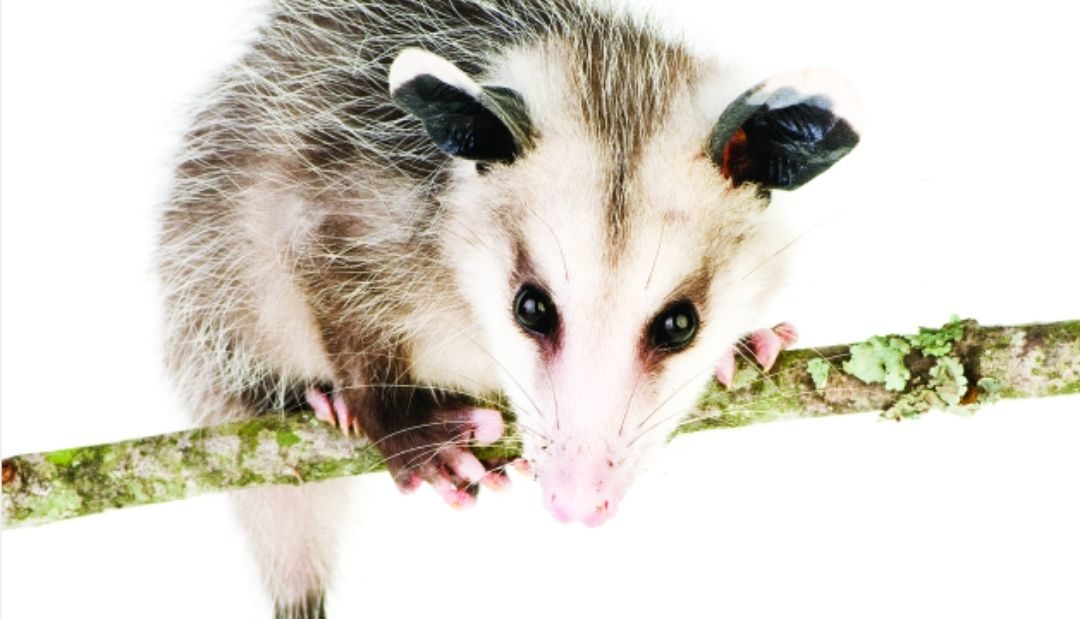Written by Pam Varga, Chairman of the Sahli Nature Park Advisory Committee
Bright shiny dark eyes, a pointy little pink nose – what could be cuter than a possum’s face, right? But some people may think possums are ugly. Whether you think they are adorable or horrible, possums are very unusual animals.
The possum is the only marsupial in North America. A marsupial is an animal that carries its babies in a pouch, like an Australian kangaroo. A female possum has a pouch on her belly. Her tiny babies, born in litters of 1 – 14, are about as big as honeybees, about 0.5 inches long, and weighing just 0.005 ounces. The blind and hairless newborns must crawl up mama’s belly into the pouch without any assistance from her. Safe inside the pouch, the babies attach themselves to mama’s nipples and drink her rich milk. When they are about two months old, the furry babies will emerge from the pouch and ride on mom’s back. In 3 -4 months, the babies will leave their mama and live solitary lives as possums do.
Weighing about 4 – 14 pounds, an adult possum is about as big as a house cat with black tipped gray fur, a white undercoat, and black hairless ears. Their prehensile tails are hairless and scaly. Prehensile means their tails are very flexible and can wrap around branches to help the possum climb trees. Baby possums can even hang from branches by their tails. The possum has “thumbs” on its hind feet which also help it climb. They are also slow but good swimmers. Possums are nocturnal; they are active at dusk and during the night.
Unlike many wild mammals, opossums do not hibernate during the winter. They make a nest of grasses and leaves in a hollow log, rock or wood pile, thick brush, abandoned burrows and even under buildings and porches. On cold days, the possum will remain in its nest to protect its hairless ears and tail from frostbite, but on warmer days the possum will leave its nest to search for food.
Possums are omnivores. They eat a wide variety of plants and animals – worms, snails, frogs, birds, snakes, small mammals, eggs, acorns, nuts, berries, fruit, and corn. They eat carrion and roadkill, making them an important part of nature’s clean-up crew. They also eat ticks. One possum can eat as many as 5,000 ticks in a season without getting Lyme disease, making them natural pest controllers. They are also immune to Rabies and snake venom.
The term “playing possum” means playing dead or pretending not to know something, and possums are truly expert at playing dead. Due to their slow movements, poor hearing, and nearsightedness, possums would be easy prey. When threatened, the possum will first try to run away or climb a tree, but it is very slow at both. It will then hiss, screech, growl, and show its sharp teeth. If all of that fails to frighten away a predator, the possum goes limp and falls over. Its eye close, its tongue hangs out, it may foam at the mouth or drool, and it excretes a fowl smelling green substance. Even if touched or rolled over, the possum remains limp and unresponsive. Usually, the predator will lose interest in this dead smelly thing and walk away. Playing dead is a very efficient defensive strategy.
The opossum’s biggest enemy is man. Because of their slowness and habit of eating roadkill, many possums are victims of cars. Because they may eat garbage and live under house and porches, many humans view possums as pests. In some parts of the country they are hunted for food and fur. The possum has a very short life span of only 1 – 2 years. Four years is the longest they may survive.
At Sahli Nature Park, you may see an opossum at dusk eating apples by the bird feeders or during warm winter days ambling through the forest in search of food. While you still may not think they are cute, perhaps you have come to have a better appreciation for this unique Pennsylvania mammal.







